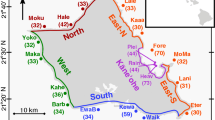Abstract.
The objective of this work is to identify which substrata characteristics (such as coral morphology, coral diversity, coral species richness, percentage coverage by live coral or by algae) influence the structure and abundance of fish communities. The study was carried out at Reunion Island, Indian Ocean, where six sites were sampled in two zones (reef flat and outer reef slope). Quantitative data were collected by visual census techniques, along a linear transect of 50 m for the substratum, and a belt of 50×2 m for the fish communities. Correspondence analysis (CA) and an optimising cluster analysis, called dynamic clustering method (DCM) were used to describe and compare fish assemblages with the benthic composition. The relationships between benthic and fish communities were examined using the classes revealed by the partitioning of the substratum with DCM. This partitioning allowed us to derive four classes of substratum: the non-disturbed reef flat, the non-disturbed outer reef slope, the perturbed reef habitat and the reef pass. The analysis of the partitioning based on the coral variables suggests that there are significant relationships between benthic and fish assemblages.
Similar content being viewed by others
Author information
Authors and Affiliations
Additional information
Accepted: 26 July 1996
Rights and permissions
About this article
Cite this article
Chabanet, P., Ralambondrainy, H., Amanieu, M. et al. Relationships between coral reef substrata and fish. Coral Reefs 16, 93–102 (1997). https://doi.org/10.1007/s003380050063
Issue Date:
DOI: https://doi.org/10.1007/s003380050063




